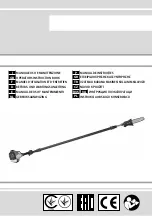
Model G0715P (Mfg. 4/11+)
-41-
Commonly used in furniture joinery, a rabbet is an
L-shaped groove cut in the edge of the workpiece.
Rabbets can be cut with either a dado blade or a
standard saw blade.
Rabbet cutting on the edge of the workpiece with
a dado blade requires a sacrificial fence (
Figure
55). Make the sacrificial fence the same length as
the fence and
3
⁄
4
" thick. Attach it to the fence with
screws or clamps, making sure they are all secure
and tight. Raise the blade into the sacrificial fence
to the height needed.
Rip Fence
Sacrificial
Fence
Dado Insert
Blade Cut-Out
Figure 55. Sacrificial fence.
Rabbet Cutting
Always use push sticks, featherboards,
push paddles and other safety accessories
whenever possible to increase safety and
control during operations which require
that the blade guard be removed from the
saw. ALWAYS replace the blade guard after
dadoing is complete.
Dado blades have a higher risk of kickback
than normal blades because their larger size
applies stronger forces to the workpiece.
This risk increases relative to the depth and
width of the cut. To minimize your risk of
serious personal injury, ensure that stock
is flat and straight, and make multiple light
cuts (rather than one deep cut) to achieve
the desired cutting depth.
Workpiece
Fence
Dado Blade
Sacrificial Fence
Figure 56. Rabbet cutting.
4. Reconnect the saw to the power source
and turn the saw
ON. When the blade has
reached full speed, perform a test cut with a
scrap piece of wood.
—
If the cut is satisfactory, repeat the cut with
the final workpiece.
3. Adjust the fence and align the workpiece to
perform the cutting operation, as shown in
Figure 56.
1. DISCONNECT SAW FROM POWER!
2. Adjust the dado blade to the height needed
for the rabbeting operation. When cutting
deep rabbets, take more than one pass to
reduce the risk of kickback.
Cutting Rabbets with a Dado Blade
Summary of Contents for G0715P
Page 18: ... 16 Model G0715P Mfg 4 11 Hardware Recognition Chart ...
Page 88: ......
















































